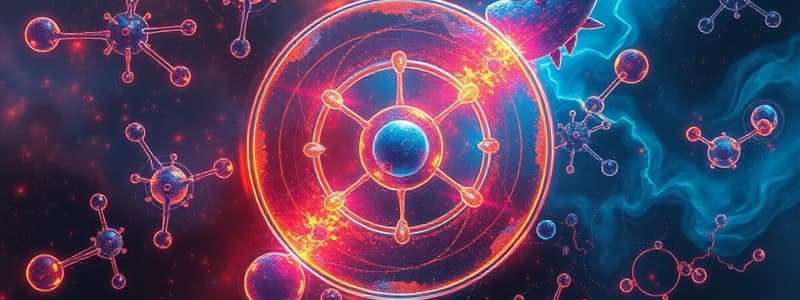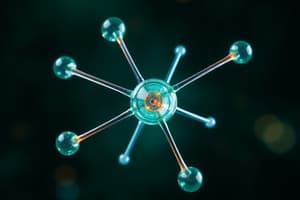Podcast
Questions and Answers
What are hydrocarbons composed of?
What are hydrocarbons composed of?
- Hydrogen and carbon (correct)
- Oxygen and nitrogen
- Hydrogen and oxygen
- Carbon and nitrogen
Which of the following is a proper example of Personal Protective Equipment (PPE)?
Which of the following is a proper example of Personal Protective Equipment (PPE)?
- Test tubes
- Laboratory manuals
- Chemical reagents
- Safety goggles (correct)
What is the key purpose of functional groups in organic chemistry?
What is the key purpose of functional groups in organic chemistry?
- To stabilize chemical reactions
- To determine the characteristics and reactivity of compounds (correct)
- To dissolve hydrocarbons
- To eliminate hazardous waste
Which of the following best describes proper waste disposal in a laboratory setting?
Which of the following best describes proper waste disposal in a laboratory setting?
Why is understanding foundational concepts in chemistry important?
Why is understanding foundational concepts in chemistry important?
Which state of matter has a definite volume but no definite shape?
Which state of matter has a definite volume but no definite shape?
What determines the atomic number of an element?
What determines the atomic number of an element?
Which type of bond involves the transfer of electrons?
Which type of bond involves the transfer of electrons?
In a chemical reaction, what are the substances formed called?
In a chemical reaction, what are the substances formed called?
Which of the following describes a synthesis reaction?
Which of the following describes a synthesis reaction?
Which group of the periodic table contains elements with similar chemical properties?
Which group of the periodic table contains elements with similar chemical properties?
What type of substance donates protons (H+) in solution?
What type of substance donates protons (H+) in solution?
On the pH scale, what value represents a neutral solution?
On the pH scale, what value represents a neutral solution?
Flashcards are hidden until you start studying
Study Notes
Introduction to Chemistry
- Definition: Chemistry is the scientific study of matter, its properties, composition, structure, and the changes it undergoes during chemical reactions.
States of Matter
- Solid: Definite shape and volume, particles are closely packed.
- Liquid: Definite volume but no definite shape, particles are closely packed but can flow.
- Gas: No definite shape or volume, particles are far apart and move freely.
Atomic Structure
- Atoms: Basic units of matter, composed of:
- Protons: Positively charged particles in the nucleus.
- Neutrons: Neutral particles in the nucleus.
- Electrons: Negatively charged particles that orbit the nucleus.
- Atomic Number: Number of protons in an atom's nucleus; defines the element.
- Mass Number: Total number of protons and neutrons in an atom.
Chemical Bonds
- Ionic Bonds:
- Formed by the transfer of electrons from one atom to another.
- Typically occurs between metals and nonmetals.
- Covalent Bonds:
- Formed by the sharing of electrons between atoms.
- Typically occurs between nonmetals.
- Metallic Bonds:
- Occur in metals, where electrons are shared amongst a lattice of positively charged ions.
Chemical Reactions
- Reactants: Substances that undergo change in a chemical reaction.
- Products: Substances formed as a result of a chemical reaction.
- Types of Reactions:
- Synthesis: Two or more substances combine to form a new compound.
- Decomposition: A compound breaks down into simpler substances.
- Single Replacement: One element replaces another in a compound.
- Double Replacement: Exchange of ions between two compounds.
- Combustion: Reaction of a substance with oxygen, producing energy.
The Periodic Table
- Organization: Elements are arranged by increasing atomic number and grouped by similar properties.
- Groups: Vertical columns; elements in the same group have similar chemical properties.
- Periods: Horizontal rows; properties change gradually across a period.
Acids and Bases
- Acids: Substances that donate protons (H+) in solution; have a sour taste and turn blue litmus paper red.
- Bases: Substances that accept protons or donate hydroxide ions (OH-) in solution; have a bitter taste and turn red litmus paper blue.
- pH Scale: Measures the acidity or basicity of a solution; ranges from 0 (acidic) to 14 (basic), with 7 being neutral.
Organic Chemistry
- Definition: Study of carbon-containing compounds and their properties.
- Hydrocarbons: Compounds composed only of hydrogen and carbon.
- Functional Groups: Specific groups of atoms within molecules that determine the characteristics and reactivity of the compound.
Chemical Safety and Laboratory Practices
- Personal Protective Equipment (PPE): Safety goggles, gloves, lab coats.
- Proper Waste Disposal: Follow protocols for hazardous and non-hazardous waste.
- Emergency Procedures: Know the locations of safety showers, eye wash stations, and fire extinguishers.
Conclusion
- Chemistry is a vast field that combines principles of physics, biology, and environmental science, impacting a multitude of real-world applications. Understanding its foundational concepts is crucial for further studies in scientific disciplines.
Introduction to Chemistry
- Chemistry studies matter, including its properties, composition, structure, and changes during chemical reactions.
States of Matter
- Solid: Has a definite shape and volume; particles are closely packed and rigid.
- Liquid: Has a definite volume but no fixed shape; particles are packed closely but can move freely, allowing flow.
- Gas: Lacks definite shape or volume; particles are spaced far apart and move independently.
Atomic Structure
- Atoms: Fundamental units of matter, consisting of protons, neutrons, and electrons.
- Protons: Positively charged, located in the nucleus.
- Neutrons: Neutral, found in the nucleus alongside protons.
- Electrons: Negatively charged, orbit around the nucleus in electron shells.
- Atomic Number: The number of protons in an atom, identifying the element.
- Mass Number: Sum of protons and neutrons in an atom's nucleus, crucial for determining isotopes.
Chemical Bonds
- Ionic Bonds: Result from electron transfer between atoms; usually occur between metals (which lose electrons) and nonmetals (which gain electrons).
- Covalent Bonds: Formed through electron sharing between nonmetals, resulting in molecule formation.
- Metallic Bonds: Found in metals, where electrons are delocalized among a lattice of positively charged ions, allowing conductivity.
Chemical Reactions
- Reactants: Starting substances that undergo transformation in a reaction.
- Products: Resulting substances formed from a chemical reaction.
- Types of Reactions:
- Synthesis: Two or more reactants combine to form a new product.
- Decomposition: A single compound breaks down into simpler products.
- Single Replacement: An element replaces another in a compound.
- Double Replacement: The exchange of ions between two compounds occurs.
- Combustion: A substance reacts with oxygen, typically producing heat and light.
The Periodic Table
- Elements are systematically arranged by increasing atomic number, grouped by similar properties.
- Groups: Vertical columns where elements share similar chemical properties.
- Periods: Horizontal rows; property variations occur across periods.
Acids and Bases
- Acids: Donate protons (H+) in solution; characterized by a sour taste and ability to turn blue litmus paper red.
- Bases: Accept protons or donate hydroxide ions (OH-); typically have a bitter taste and turn red litmus paper blue.
- pH Scale: Ranges from 0 to 14, indicating acidity (0-7), neutrality (7), and basicity (7-14).
Organic Chemistry
- Focuses on carbon-containing compounds, exploring their properties and reactions.
- Hydrocarbons: Composed solely of hydrogen and carbon atoms.
- Functional Groups: Specific atom groups that influence the chemical behavior of organic molecules.
Chemical Safety and Laboratory Practices
- Personal Protective Equipment (PPE): Essential safety gear includes goggles, gloves, and lab coats.
- Proper Waste Disposal: Adhere to protocols for separating hazardous and non-hazardous waste.
- Emergency Procedures: Familiarize with safety stations like showers, eyewash, and fire extinguishers.
Conclusion
- Chemistry encompasses diverse scientific principles and has profound real-world applications, making mastery of foundational concepts essential for advanced study in various scientific fields.
Studying That Suits You
Use AI to generate personalized quizzes and flashcards to suit your learning preferences.




